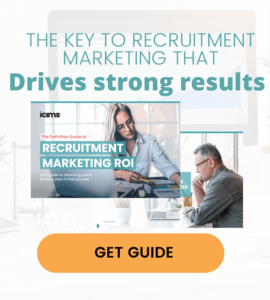- Solutions
- Products
- Community
- Resources
- Company
Create incredible candidate experiences that communicate your brand, mission, and values with recruitment marketing solutions.
Learn moreCommunicate effectively and efficiently with the candidates that can drive your business forward.
Learn moreSelect the right candidates to drive your business forward and simplify how you build winning, diverse teams.
Learn moreHelp your best internal talent connect to better opportunities and see new potential across your entire organisation.
Learn moreCommunicate collectively with large groups of candidates and effectively tackle surges in hiring capacity.
Learn moreAccess tools that help your team create a more inclusive culture and propel your DEI program forward.
Learn moreRebound and respond to the new normal of retail with hiring systems that are agile enough to help you forge ahead.
Learn moreAccelerate the hiring of key talent to deliver point of care and support services that meet and exceed your promise of patient satisfaction.
Learn moreAttract and engage candidates with technical competencies, accelerate hiring for much-needed skills, and advance expertise within your valued workforce.
Learn moreSimplify how you recruit finance, insurance, and banking candidates with a unified platform built to match top talent with hard-to-fill roles.
Learn moreYour business strategy depends on your people strategy. Keep both in lockstep with the iCIMS Talent Cloud.
Learn moreBuild an engaging, high-converting talent pipeline that moves your business forward.
Learn moreDeliver the innovation your talent team needs, along with the global scale and security you demand.
Learn moreDeliver tailored technology experiences that delight users and power your talent transformation with the iCIMS Talent Cloud.
Learn moreThe #1 ATS in market share, our cloud-based recruiting software is built for both commercial and large, global employers.
Learn more Talk to salesAttract the best talent for your business with powerful, on-brand career websites that excite candidates and drive engagement.
Learn more Talk to salesBuild talent pipelines, engage candidates with multi-channel marketing campaigns, and use machine learning to automatically surface the right talent for the job.
Learn more Talk to salesEmpower candidates with automated self-service, qualification screening, and interview scheduling through an AI-enabled digital assistant.
Learn more Talk to salesSimplify employee onboarding with automated processes that maximize engagement and accelerate productivity.
Learn more Talk to salesRecruit in the modern world and expand your reach with built-in virtual interviewing.
Learn more Talk to SalesFocus on qualifying candidates faster with fully integrated language assessments.
Learn more Talk to SalesImprove employee experience, retention, and reduce internal talent mobility friction with the iCIMS Opportunity Marketplace.
Learn more Talk to salesCompliment your sourcing and engagement efforts with sophisticated lead scoring and advanced campaign personalization.
Learn more Talk to salesModernize, streamline, and accelerate your communication with candidates and employees.
Learn more Talk to salesTransform the talent experience by showcasing your authentic employer brand through employee-generated video testimonials.
Learn more Talk to salesGive your business a competitive edge with a complete solution for creating personalized, timely, and accurate digital offer letters that inspire candidates to want to join your team.
Learn more Talk to SalesGet robust analytics that help you make sense of your data and illuminate your talent pool.
Learn moreSimplify recruiting, dynamically engage talent, and reduce hiring bias with job matching and recruiting chatbot technology.
Learn more Talk to salesThe #1 ATS in market share, our cloud-based recruiting software is built for both commercial and large, global employers.
Learn more Talk to salesAttract the best talent for your business with powerful, on-brand career websites that excite candidates and drive engagement.
Learn more Talk to salesBuild talent pipelines, engage candidates with multi-channel marketing campaigns, and use machine learning to automatically surface the right talent for the job.
Learn more Talk to salesEmpower candidates with automated self-service, qualification screening, and interview scheduling through an AI-enabled digital assistant.
Learn more Talk to salesSimplify employee onboarding with automated processes that maximize engagement and accelerate productivity.
Learn more Talk to salesCompliment your sourcing and engagement efforts with award-winning lead scoring and advanced campaign personalization.
Learn moreImprove employee experience, retention, and reduce internal talent mobility friction with the iCIMS Opportunity Marketplace.
Learn more Talk to salesModernise, streamline, and accelerate your communication with candidates and personnel.
Learn more Talk to salesTransform the talent experience by showcasing your authentic employer brand through employee-generated video testimonials.
Learn more Talk to salesGet robust analytics that help you make sense of your data and illuminate your talent pool.
Learn moreSimplify recruiting, dynamically engage talent, and reduce hiring bias with job matching and recruiting chatbot technology.
Learn more Talk to salesHow PRMG attracts 50% more applicants for niche finance roles with the iCIMS Talent Cloud.
Learn moreThousands strong, our global community of talent professionals includes creatives, innovators, visionaries, and experts.
Learn moreTogether we’re creating the world’s largest ecosystem of integrated recruiting technologies.
Learn moreExplore our network of more than 300 certified, trusted third-party service and advisory partners.
Learn moreExpert guidance about recruitment solutions, changes in the industry, and the future of talent.
Learn moreExpert guidance about recruitment solutions, changes in the industry, and the future of talent.
Learn moreStay up to date with the latest terminology and verbiage in the HR software ecosystem.
Learn morePartner with iCIMS to build the right strategies, processes, and experience to build a winning workforce.
Learn moreThe iCIMS Talent Cloud delivers a secure, agile, and compliant platform designed to empower talent teams, job seekers, and partners with advanced data protection and privacy.
Learn moreWatch the recording of our latest webinar looking at key findings from a recent study and explore short-term and long-term solutions for the talent crisis in 2022 and beyond.
Watch on-demandView press releases, media coverage, and the latest hiring data. See what analysts are saying about iCIMS.
Learn moreiCIMS is the Talent Cloud company that empowers organizations to attract, engage, hire, and advance the talent that builds a winning workforce.
Learn moreGet to know the award-winning leadership team shaping the future of the recruiting software industry.
Learn moreWe believe the future of work isn't something that "happens" to you. It's something you create. We actively create the future of work with our customers every day.
Learn moreStreamline your tech stack and take advantage of a better user experience and stronger data governance with ADP and the iCIMS Talent Cloud.
Learn moreThe combined power of iCIMS and Infor helps organizations strategically align their business and talent objectives.
Learn moreOur award-winning partnership with Microsoft is grounded in a shared desire to transform the workplace and the hiring team experience.
Learn moreOur partnership with Ultimate Kronos Group (UKG) supports the entire talent lifecycle by bringing frictionless recruiting solutions to UKG Pro Onboarding.
Learn moreLet’s get in touch. Reach out to learn more about iCIMS products and services.
Learn more
There’s a lot companies can measure throughout the hiring process. With the right tools, measuring is the easy part. Knowing what to measure and how to communicate and act on it is another.
Today we’ll look at three examples of companies using metrics to inform how they attract and engage candidates, source from a more diverse pool of candidates, and save money every year by helping to improve their hiring efficiency.
Three very different companies with very different challenges and approaches.
In each, you’ll notice an underlying theme: The ability to measure performance generally improves performance. The ability to communicate proof of concept to business leaders – and not just those in HR – frees up additional resources and improves performance further.
Ready to learn more about KPIs, metrics, and more? Check out our guide, Actionable analytics: Your path to a strong recruitment marketing ROI.

Here are the four key metrics Cedar Fair monitors daily during hiring season:
Cedar Fair’s recruiters get in the weeds with these numbers, keeping close eyes on their personalized analytics dashboards. But they aren’t the only ones interested. Their success is the company’s success. Higher-level reports, including the numbers above, get sent to executives daily in the run-up to park openings.
Read more of Cedar Fair’s story here.

Before the iCIMS Talent Cloud, Celanese’s recruiting process was completely manual. This made hiring between 750 and 950 positions per year across 42 countries more complicated than it needed to be. But the company was facing a growing challenge that surpassed the need to hire quickly: a lack of interested candidates.
For many, working in the manufacturing industry isn’t the most glamorous of jobs. Some candidates never consider it because they may hold outdated perceptions of loud, noisy plants and working long hours for little pay. This isn’t modern manufacturing, and it isn’t Celanese.
Many manufacturing jobs are highly specialized. They’re niche positions that require very specific credentials. The resulting pool of qualified candidates is far smaller than many manufacturers would like.
For Celanese, the answer is growing their workforce responsibly and intentionally. This includes a commitment to sourcing diverse candidates and bringing historically underrepresented groups (including women and ethnic minorities) into quality, stable manufacturing careers.
Robust metrics and reporting give Celanese’s team a 360-degree view into its diversity hiring efforts – a major priority for its executive team.
Recruiters monitor diversity metrics throughout the hiring process and see if there are areas where candidates drop out. Knowing when, where, and why diverse candidates fall off has helped them up their game, including showcasing diverse employees throughout the company in short, snackable videos.
“Pulling that data when you’re all in one system is essential,” says Jim D’Amico, Global Talent Acquisition Leader at Celanese. “We can put together comparative data, and not just on the basic talent metrics.”
Today, 93% of Celanese’s hiring slates include diverse candidates, up from 77% just a couple of years ago.
Read more of Celanese’s story here.

What’s worse, there’s no one you can ask. Making dinner, once usually such an achievable task, has becomes nearly impossible.
AmTrust Financial’s recruiting team once found themselves in a similar predicament. Their recruiting suffered because they didn’t have insight into what was working and what wasn’t.
“We had a very old applicant tracking system – I call it the dinosaur of applicant tracking systems,” says Kimberly Bowen, AmTrust’s former VP of Talent Acquisition.
“It didn’t have any automation and didn’t give us good data. It was really difficult to evaluate how we were doing moving candidates through the workflow.”
The lack of automation meant Bowen’s team spent a lot of extra time logging in and out of systems and doing redundant tasks. That could be addressed, given the proper tools. The real challenge was that her team didn’t know where to spend their time and effort sourcing candidates. This led to tension in the business.
“We were in the stone age. Our business leaders thought recruiting wasn’t working, that the recruiting team wasn’t doing everything to get them good talent.”
Bowen’s team was leaning heavily on outside agencies to fill the roles they needed. It wasn’t a great look.
The solution? AmTrust desperately needed a new ATS that could integrate with their existing Workday system. Bowen’s team evaluated six vendors before going with the iCIMS Talent Cloud to rebuild AmTrust’s recruiting.
Clear, precise data keeps AmTrust’s executives happy – as does saving $13,000,000 per year in recruiting agency fees. That’s thanks to Bowen’s team, who now have insight into what’s working and what’s not, allowing them to make data-driven decisions.
Read more of AmTrust Financial’s story here.
We don’t track recruiting KPIs because it’s good for our health. We do it to see what’s working and what isn’t. Just as important is doing so in such a way that it’s easy to communicate success and ongoing challenges to business leadership. Then, and only then, do we get the buy-in and resources we need to address those challenges head-on.
Ready to learn more about KPIs, metrics, and more? Check out our guide, Actionable analytics: Your path to a strong recruitment marketing ROI.

and receive free tips on how to attract, engage, hire, & advance the best talent.




